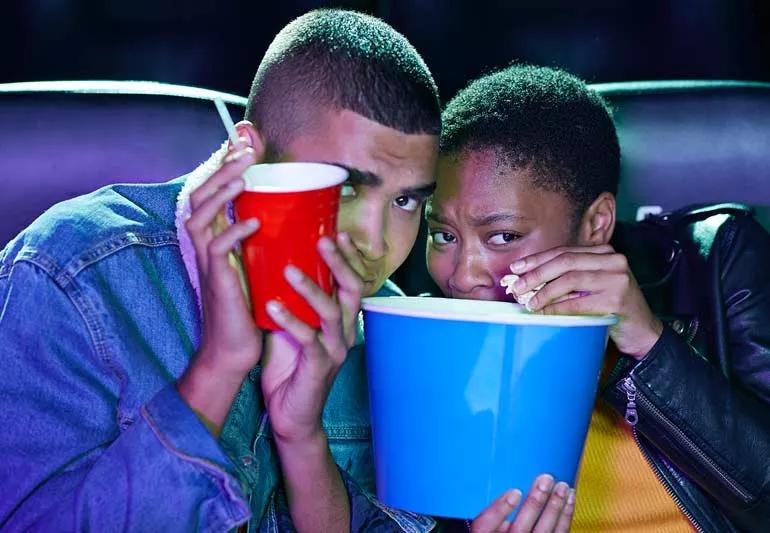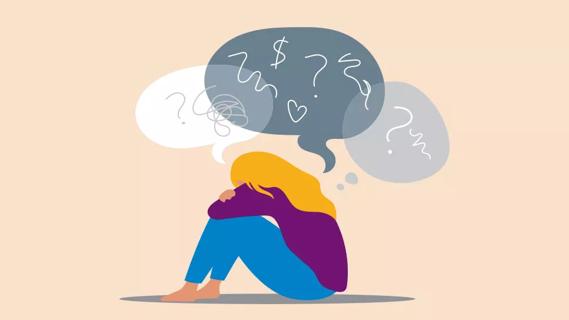Our brains are hardwired to enjoy being scared … that is, as long as there’s no real danger

Why are so many of the longest-running TV shows about murder? Why is the scariest house on the block everybody’s favorite trick-or-treat spot? Why would anybody in their right mind get on a rollercoaster?! Why, exactly, do so many of us enjoy being scared?
Advertisement
Cleveland Clinic is a non-profit academic medical center. Advertising on our site helps support our mission. We do not endorse non-Cleveland Clinic products or services. Policy
When we choose to participate in frightening activities, we’re manipulating our brains into a series of chemical reactions that make us feel good. For that reason, a little terror is actually good for us.
Fear is an emotion, yes, but what’s the mechanism behind it? What is it that we’re feeling when we feel fear?
The short answer is: a lot. Several simultaneous processes are happening in our bodies when we’re frightened:
Fear is a full-body experience. So, while it’s extremely rare to be scared to death, there’s a good reason you have to sign waivers to enter so-called “extreme” haunted houses.
The many sensations that make up fear are evolutionary adaptations. Combined, they keep us from cuddling tigers, jumping off cliffs or standing out in the open during a lightning storm.
Advertisement
In short — fear helps keep us alive.
But if fear is such an important response, why do we so enjoy provoking it?
It turns out, there are many reasons getting freaked out can be fun.
According to psychologist Chivonna Childs, PhD, the thing that distinguishes good fear from bad fear is our perception of safety. “Fear lets us know that we need to run,” she says. “If there’s a bear coming, I need to know what to do. I need to run. That’s a kind of fear that can breed anxiety and depression.”
She continues, “There’s also a good side to fear, and that’s what scary movies, true crime and haunted houses tap into. We understand that there’s an end to those experiences, that the bear’s not gonna get us. We know that going through a haunted house is just for fun, that it’s only people in costumes. But it still rings those bells for adrenaline, endorphins and dopamine. You experience the euphoria because you know you’re safe.”
Have you ever wondered why people laugh as they get off a roller coaster or leave a theater after a really scary movie? It’s because we’re enjoying the chemical rush that we get when we’re threatened, minus all that stress.
Speaking of stress, we’ve all been in situations that made us want to scream, cower or run away. Whether it’s an argument with a coworker, a funeral for a friend or Thanksgiving at your weird uncle’s house, we’re expected to show a certain level of decorum in our everyday lives.
When we ride rollercoasters, watch horror movies or listen to ghost stories around a campfire, though, the opposite is true: We’re supposed to have extreme reactions. These situations give us an opportunity to express our emotions in ways that, in other contexts, would be socially unacceptable.
According to Dr. Childs, getting scared without being in real danger can be very cathartic. “It improves our mood,” she says. “We’ve let some stress out. We’ve screamed a little. So, we feel a little bit better after we’ve been to a good, scary movie or walked through a haunted house.”
In addition to making space for us to vent our feelings, nonthreatening scary content also offers the opportunity to prove our strength. Put differently, successfully enduring something we regard as spooky is satisfying.
Dr. Childs explains, “We get a sense of accomplishment. I made it through this haunted house, or I watched the whole scary movie, and I was OK. Yes, Jason is in the woods, but he didn’t get me.”
That feeling is further amplified when it’s not “me,” but “we.”
The emotions we feel when watching, listening to or engaging with something scary are magnified when we’re with other people.
“When we’re in crowds, fear-induced euphoria bonds people. That’s part of the fun. Because you bond when you’re with the people that you’re scared with,” explains Dr. Childs.
Advertisement
That’s why haunted houses, scary movies and the like make for a great date night. Fear is a form of arousal akin to sexual arousal. When we’re scared but safe, we can indulge our desire to get and stay close to other people.
A steady diet of spooks does more than just impact us physically. It also helps us better understand and move through the world we live in.
Most stories have some kind of lesson or moral attached to them. They also tend to reflect the historical moment in which we find ourselves, and the challenges that attend it. Have you ever noticed that all the books about vampires seem to come out at the same time, or that every major streaming service seems to pick up a zombie-themed show at the same time? That’s because the media we watch reflects the specific anxieties of our time.
When we interact with these kinds of media, we’re doing more than entertaining ourselves — we’re holding up a mirror — teaching ourselves about the dangerous world we live in, and deciding how we want to navigate it.
“These stories are cautionary tales,” Dr. Childs notes. “They remind us to be careful about where you’re going. To be aware of your surroundings. That not everybody who looks like a nice person is a nice person. It helps us to think through what we would do if we were in those types of situations.”
Advertisement
Of course, not all scary stories invite us to identify with the victim. Some do exactly the opposite: They make us root for the bad guy.
Have you ever been listening to a true crime podcast and thought to yourself, “What an amateur!” And, before you know it, you’re daydreaming about committing the “perfect murder.”
While perhaps a bit unsettling, it’s also a normal response. There’s a difference between thinking transgressive thoughts and committing transgressive acts. Indulging our spooky side lets us confront our demons without harming anybody or betraying our morals.
Exploring the darkest elements of the human experience also helps reinforce our belief systems. It shows us who we are, by showing us who we are not.
As Dr. Childs puts it, “I don’t want to be a serial killer, but I do want to know how a serial killer thinks. Was this a normal guy? John Wayne Gacy, Ted Bundy, all these real-life people that did horrific things — how did they get to that space? What was going on in their minds that they thought that this was OK?”
Sometimes, we engage with frightening material not to understand who we are, but to feel prepared in the face of real challenges.
In the early days of COVID-19 lockdown, for example, the 1995 film Outbreak was one of the most popular films on Netflix in the United States. The film tells the (fictional) story of a small town gripped by a doomsday virus.
Advertisement
It doesn’t sound like escapism at first blush. But by the end of the film (SPOILER ALERT!), the heroes have cured the disease, punished the bad guys and even rekindled a lost romance — all within a few days.
Outbreak became a kind of immersion therapy, a way for Americans to get accustomed to the idea of a pandemic and to reassure ourselves that, eventually, everything was going to be OK.
Of course, everything can only be OK for so long. Eventually, we’re all going to die. For that reason, death features prominently in a lot of the scary activities we enjoy.
According to Dr. Childs, holidays like Halloween or Día de los Muertos help us come to terms with the inevitability of death. “These days of death are celebrations. We get to look at death as a transition, instead of it being this horrible, bad thing.”
That might sound somewhat counterintuitive. After all, aren’t the deaths in horror movies and the like, you know … horrible?
Dr. Childs explains: “It puts us into this mindset of ‘I don’t want to die this way. I don’t want to die that way.’ And so we sit here thinking about all the ways we would want to die, since we have to do it.”
For most of us, coming to terms with death is a lifelong process. Cursed mummies, axe murderers and rogue sharks can’t eliminate our fear of the inevitable, but they can make the prospect of a “normal” death seem better by comparison.
While, generally speaking, a little fear is good for you, that doesn’t mean you should expose yourself to everything. Remember, the primary difference between good and bad fear is the feeling of danger. Small children aren’t able to distinguish between real danger and make-believe danger, which is why we often try to shield them from scary content.
As we grow, our sense of safety grows, too, but it isn’t absolute. We all have third rails that make certain kinds of fear unpleasant.
What we perceive as a threat is intimately connected to who we are.
Dr. Childs offers up the example of horror movies with religious themes. “Many of us can do fantasy fear because fantasy fear is just that: Its fantasy. We’re pretty sure vampires, werewolves and Frankenstein’s monsters don’t exist, so we can be OK watching that,” she explains. “But when it comes to angels and demons — depending on our religious beliefs — that can be a very real thing for us. So, that might be a thing that some people want to steer away from.”
Our life experiences also play a role in how we respond to scary stimuli. “Any kind of trauma is going to impact the type of content you can tolerate,” Dr. Childs states. Take true crime, for example. If you or someone you love has experienced violence, stories that mirror those experiences might be triggering.
The same goes for intergenerational trauma. The controversy surrounding the 2022 Netflix series “Monster” — which chronicles the crimes of serial killer Jeffrey Dahmer — is instructive here.
The show explores Dahmer’s motivation for killing. It also includes prolonged, graphic scenes of his attacks on his victims, and recounts, in excruciating detail, the ways that hate, homophobia and police violence made Dahmer’s crimes possible. Reactions to the series have been extremely positive and extremely negative, in large part because the content hits closer to home for some communities than for others.
Knowing what kind of content you, personally, find “too real” will help you avoid psychological landmines.
Sometimes, healthy fear goes too far.
Maybe you cross the street whenever there’s somebody else heading your way on the sidewalk. Maybe you doomscroll on social media and watch cable news for hours a day. Maybe you check and re-check your locks throughout the night for fear of a home invasion. Maybe you skip trips to the amusement park because you can’t stand to be near a roller coaster.
These are signs you’ve tipped from healthy fear into anxiety or panic.
“That’s when I would suggest seeking out help from friends and family,” Dr. Childs says. “If it continues to go on, there’s a bell being rung there. There’s something that has happened, something that is being experienced, and it might be time to seek therapy to see what that something is.”
According to Dr. Childs, “We can remind ourselves all day that it was just a movie, or a podcast or a haunted house tour. But if it keeps touching a place in you that is fearful — if you can’t sleep, if it’s impacting how you function — it might be time to seek help to see what else is there. Sometimes, trauma can result in repressing memories, repressing feelings, repressing things that have happened to us, so it’s a good idea to seek professional help.”
Whether you’re a horror movie maven, a true crime connoisseur or a Halloween hobbyist, rest assured: Your love of a good scare is perfectly normal, and can actually be good for you! Just be sure to step away if the fright starts to feel too real.
Learn more about our editorial process.
Advertisement

Managing stress can help you sleep more soundly

This fast-acting anxiety medication should never be taken with alcohol, despite what you may see on The White Lotus

Deep breathing, positive mantras and tackling negative thoughts can help get you out of your head and cool down your anxiety

Focusing on what you can see, feel, touch and hear can help you feel more present in the moment

Performance anxiety and stage fright are outsized stress responses that can creep up when you’re put on the spot

A healthy amount of anxiety can keep you safe from harm and motivate you to take action

Although different conditions, they can occur together or cause one another

Stay merry and bright by knowing your triggers and journaling throughout your visit

Babies can get congested easily, but you can calm their cough by keeping them hydrated, using nasal drops and running a humidifier

Weight loss may cause loose, sagging skin and muscle loss to your rear

Several conditions, like vitiligo and fungal infection, can cause a loss of pigmentation, leading to white spots or patches on your skin